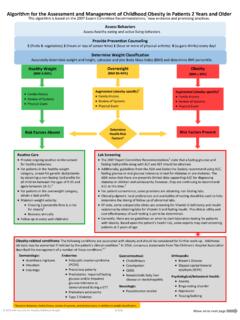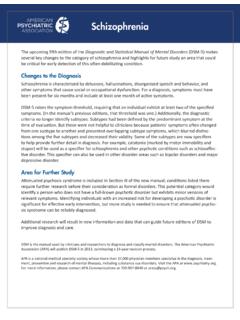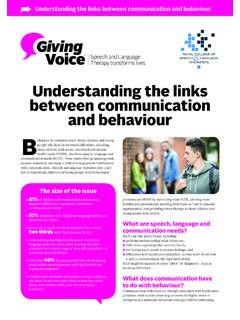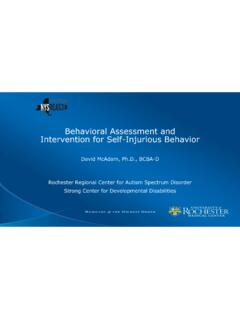Transcription of social behavior ADOS-2 Administration and Coding
1 Administration and of ADOS-2 and ADI-RGather standardised information on autism triad social behavior vocalizations/speech, gesture, non-verbal language play/ Criteria DSM / ICDQ ualitative Impairment in social interaction eye-gaze, facial expression, body postures, gestures to regulate social interaction seeking to share enjoyment, interests or achievements social or emotional Criteria DSM / ICDI mpairments in communication spoken language / gesture Initiating / maintaining conversation stereotyped repetitive idiosyncratic language make-believe or social imitative Criteria DSM / ICDR estricted, repetitive /stereotyped behaviour encompassing preoccupations, stereotyped and restricted patterns of interest; abnormal in intensity or focus inflexible adherence to routines/rituals stereotyped and repetitive motor mannerisms persistent preoccupation with parts of Autism Spectrum DisorderMust meet criteria A, B, C, and D: A Persistent deficits in social communication and social interaction across contexts BRestricted, repetitive patterns of behaviour, interests, or activities CSymptoms must be present in early childhood - but may not become fully manifest until social demands exceed limited capacities D Symptoms together limit and impair everyday functioning.
2 E Not better explained by Communication Disorder Persistent difficulties in pragmatics or social uses of verbal /nonverbal communication affects development of social reciprocity and social relationships Persistent difficulties in acquisition /use of spoken / written / other language modalities for narrative and discourse Rule out ASD Particularly in respect of restrictive repetitive behaviours Onset in early childhood when demands exceed Guidelines DSM IV / ICD-10 Autistic Disorder / Childhood Autism difficulties in all three areas age of onset < 36mAsperger s Disorder / Syndrome social interaction deficit, restricted, repetitive behaviours. no language delay and average cognitive skillsPDD-NOS / Atypical Autism social impairment language difficulties or repetitive behaviours, and ADI-RInformant interview (ADI-R) developmental history / events at onset pervasiveness and context phenotypic descriptionDirect observation ( ADOS-2 ) context to observe current behaviors include parents for young Modules One to Four Language and Developmental LevelsADOS-2 ModuleExpressive Language LevelMinimumMaximumToddler (12-30 m)No SpeechSimple PhrasesOne (> 30m)TwoFlexible Three Word Phrases*Verbally Fluent*(younger child < 6yrs)ThreeVerbally Fluent(older child / younger adolescent < 16yrs)---------FourVerbally Fluent(older adolescent/ adult)
3 Domains in Coding Section Language and Communication Reciprocal social Interaction Play / Imagination / Creativity Stereotyped Behaviours / Restricted Interests Other abnormal Conventions0 behavior of type specified is not present - not necessarily normal1 behavior of type specified is present, but not sufficiently severe, frequent or marked for code of 22 behavior of type specified definitely present and meets specific mandatory criteria3 behavior present to a degree that interferes with functioning or ordinary life7 Definite abnormality in general area of Coding , but not of type specified8 Not applicable9 Not : Features of ADOS-2 creates a social world in which behaviors related to the autism spectrum can be observed if they occur Prompts or created opportunities for these behaviours Essentially.
4 Increasing likelihood of their occurrence during observation Structured hierarchy / some Toddler Module Activities Free Play including Free Play Ball Blocking Toy Play Response to Name Bubble Play including Teasing Toy Play Anticipation of Routine with Objects including Unable Toy Play Response to Joint Attention Responsive social Smile Anticipation of social Routine Functional and Symbolic Imitation Bath Time including Bath Time Ignore Module One Activities Free Play Response to Name Response to Joint Attention Bubble Play Anticipation of Routine with Objects Responsive social Smile Anticipation of social Routine Functional and Symbolic Imitation Birthday Party Module Two Activities Construction Task Response to Name Make Believe Play Joint Interactive Play Conversation Response to Joint Attention Demonstration Task Description of Picture Telling a Story from a Book Free Play Birthday Party Snack Anticipation of Routine with objects Bubble Module Three Activities Construction Task Make Believe Play Joint Interactive Play Demonstration Task Description of Picture Telling a Story from a Book Cartoons Conversation and Reporting Emotions social Difficulties and Annoyance Break Friends and Marriage Loneliness Creating a Module Four Activities Construction Task* Telling a Story from a Book Description of Picture* Conversation and Reporting
5 Current Work or School* social Difficulties and Annoyance Emotions Demonstration Task Cartoons* Break Daily Living* Friends and Marriage Loneliness Plans and Hopes Creating a Notes on Administration Read the information with items Order is flexible Be prepared for opportunistic administrations (clinical) Be aware of ability related items and and Classification: Diagnostic Challenges Overlap in ASD / developmental delay / PD / psychiatric conditions Inter-personal variability in presentation Intra-personal (developmental) variability Broad criteria Variable interpretations of behaviours of the Diagnostic Challenges Overlap Inter-personal variability Intra-personal Broad criteria Variable interpretations of behaviours of interest Algorithm for classification Modular assessment Structured activities Operationalised descriptions Standardisation / AlgorithmFor selected items: algorithms for diagnosis ADI-R: Autism (incl.)
6 Atypical Autism, and PDD-NOS) vs. Non-Autism ADOS-2 : Autism vs. ASD/Atypical / PDD-NOS vs. Non-AutismNot specific to Asperger s Syndromes: insufficient informationFor items scored0 Remains as 01 Remains as 12 Remains as 23 Becomes 27 Becomes 08 Becomes 09 Becomes Scoring and ClassificationCode AssignedAlgorithm Score0 Unchanged as: 01 Unchanged as: 1*2 Unchanged as: 23 Converts to: 27 Converts to: 089* there is one exception to this in the Toddler ModuleWhen the item codes are transferred to page 23 of the Protocol Booklet, they are converted to algorithm scores as Scoring and ClassificationThe algorithm process in Modules 1, 2, 3 and 4 leads to an ADOS-2 classification of autism, autism spectrumor non-spectrum. The process also generates a comparison score indicating one of four levels of autism spectrum-related symptoms: high, moderate, low, algorithm process for the Toddler Module leads to an ADOS-2 Range of 1 Module 2 Module 3 Module 4 Module ScoresToddler Oliver: SA 13 RRB 4 Total 17 Moderate-to-SevereModule One Darren: SA 15 RRB 3 Total 18 Autism CS: 8 HighModule Two Penny: SA 5 RRB 2 Total 7 Non-ASD CS: 3 LowModule Three Sarah: SA 8 RRB 6 Total 14 Autism CS: 8 High Brian: SA 4 RRB 3 Total 7 ASD CS: 4 Low Bruce: SA 4 RRB 2 Total 6 Non-ASD CS: 3 Scores: Module FourModule Four Kevin: Comm 2 RSI 4 Total 10 Non-ASD Cindy: Comm 3 RSI 7 Total 10 Autism Ahmed: Comm 2 RSI 5 Total 7 ASD Remember M4 uses only.
7 Communication Total RSI TotalCommunication + RSI TotalsMust meet criterion on all and Classification - ADOS-2 Cut-Offs Cut-offs are module specific For Modules 1 to 4 three scores M1 to M3 : SA (comm. + RSI), RRB and Overall Total M4 : Communication, RSI and Total (Comm+RSI) For Modules 1 to 3 only one cut-off score Overall Total For Module Four 3 cut-offs Communication RSI and Total Comparison Score allows comparisons Between same child on different modules Between different Consensus Code all Items 0 3, 7, 8 or 9 Establish consensus score for each item Compare your score to consensus for: Total Item Set Algorithm Item Set Calculate agreement proportion Denominator excludes consensus scores > 3 Numerator is the number of agreements 3 vs.
8 2 (and vice versa) count as agreements Multiply by 100 for consensus Sets by Module Toddler Module total item set = 41; algorithm item set = 14 Module One total item set = 34; algorithm item set = 14 Module Two total item set = 29; algorithm item set = 14 Module Three total item set = 29; algorithm item set = 14 Module Four total item set = 32; algorithm item set = Items Summary vs. Specific Gathered throughout the session as a whole social Overtures and Responses, Rapport, Conversation, Reciprocal social Communication Specific early modules RJA, RSS Majority vs. Best Take the majority of examples not just the best (or vv). Conversation vs. Reporting of Events High Incidence vs. Low Incidence Several means 3; frequent, take base estimate or proportion Same title different content Early Modules: Pointing, Items Directed to Examiner or Other Early modules: MT to M2 need another person Any others (student, assistant, not considered in Coding Functional vs Imaginative Play Functional includes using objects directly as intended; representational play and constructional play Symbolic involves symbolic use of objects and pretense; using figures as agents of action; in Creating a Story using the lace as spaghetti Initiation of Joint Attention 3 point gaze shift; not holding.)
9 For Overtures and social Responses social Overture Behaviour initiated/maintained by examinee directed at examiner with purpose of communicating social intent Eye-contact, facial expression, touching, addressing verbally Subtle (checking in with eye-contact); overt (its your turn now) Poor quality (hold hand out for pieces); good quality (ask with ec / smile) social Response As above but in response to a direct approach (subtle or otherwise) by examiner Differences for Coding Don t code ABSENCE of social Overtures as unusual in the quality items. A social overture cannot be expected Do code absence of social Response. A response canbe PlayFunctional Use of toys / objects in way intended Catch / stacking blocks/reading a book / racing toy cars / talking into a toy telephone Representational/ miniatures: Toy telephones, toy cars, vehicle (dump truck), utensils, doll furniture, purse, tools, key ring, pretend food, toy rocket and teapot Cause Effect : require action: Jack-in-a-Box, balls, pop-ups Construction: primary purpose is stacking or buildingScoring Driving the truck around, (vs.)
10 Rolling it slightly), phone to ear (vs. pushing a button). PlayImaginative / Symbolic Use of toys / objects in ways not obviously intended Yarn as spaghetti / measuring cup as bath-tub Can be same toys as functional but INTENT is different Anything that involves a figure or doll in an action Giving play-doh to doll as cake or cup to doll as drinkScoring Little spontaneous judge according to age expectations Always repetitive would be 2 No use of figures or doll excludes 0 One use of doll and nothing else 2 (early Mods) One use of object in Creating a Story convention = : Pointing Toddler and Module 10 = A distal point with an index finger and co-ordinated gaze or vocalisation for Requ








